
Woke Up: Kombucha, Kale, and the New Mustang Mach E
Watch out, Tesla. Here's how the new electric Mustang held up to a Tahoe road trip.
Photography courtesy of James Henderson
I am feeling pretty freakin' ‘woke’ right now...
I am sitting outside of Whole Foods, drinking a kombucha, and charging the new Mustang Mach E. The DC fast charger will charge the fully electric Mustang from 10% to 80% in just under an hour, which is just about time to do some shopping with my compostable grocery bag, grab a kale salad, and marvel at how I am reducing my carbon footprint and saving the planet.
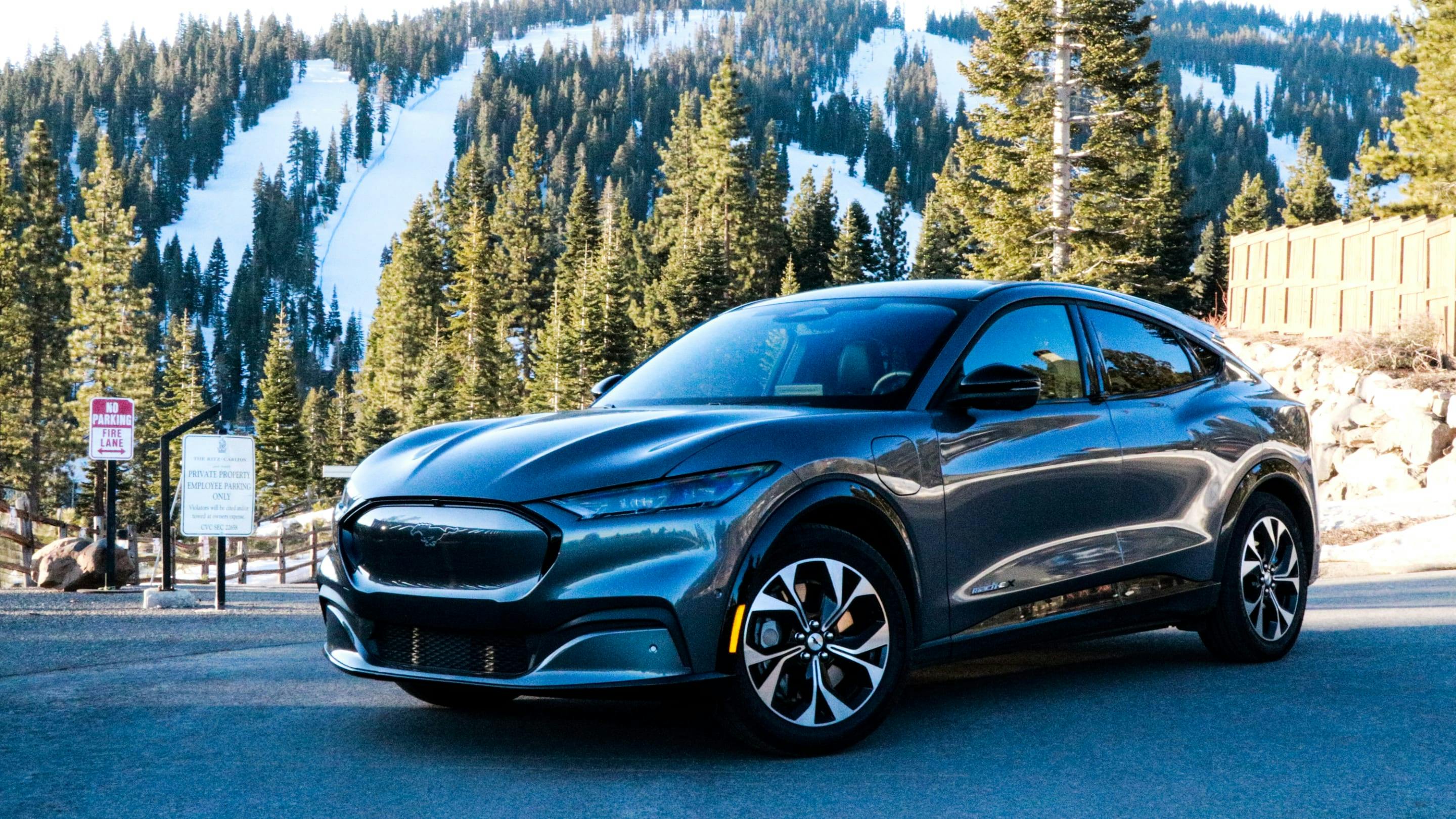
As I sip on my kombucha in the Whole Foods parking lot, however, this is perhaps the time for me to come ‘clean’—so to speak. The truth is that I hate kombucha and I really hate kale. I also find it about as difficult to get excited about an electric car as I do about a vacuum cleaner. I mean really, what’s to like. No noise. No smell. No vibration. Where’s the thrill, it all just feels a bit synthetic. For those who are regular reviewers of my blog, you will know that I have a hedonistic proclivity to the glorious V8. So, having spent years deferring the onset of the electric automobile, perhaps as one might defer a root-canal, maybe my week with the electric pony might just give me a new perspective.
With the Mach E, it seems that Ford has finally woken up and embraced the electrification of the automobile. The Mach E is Ford’s first foray as a fully electric vehicle and they have interestingly opted to badge it as a Mustang to enhance the coolness factor and go head-to-head with Tesla. Just as with the Mustang, the only reference you can find to Ford is the blue oval logo discreetly located at the top of the windscreen.
The Mach E is built on an entirely new platform and is currently available in four model options, from the base model ‘Select’ which starts with 266hp through to the GT which comes in AWD with 480hp and 600lb-ft of torque, the Performance Edition GT increases the torque to a whopping 634lb-ft. My demo car was a pre-production Mustang Mach E Premium, which came as RWD with the extended range battery and produced 290hp with 317lb ft of Torque.
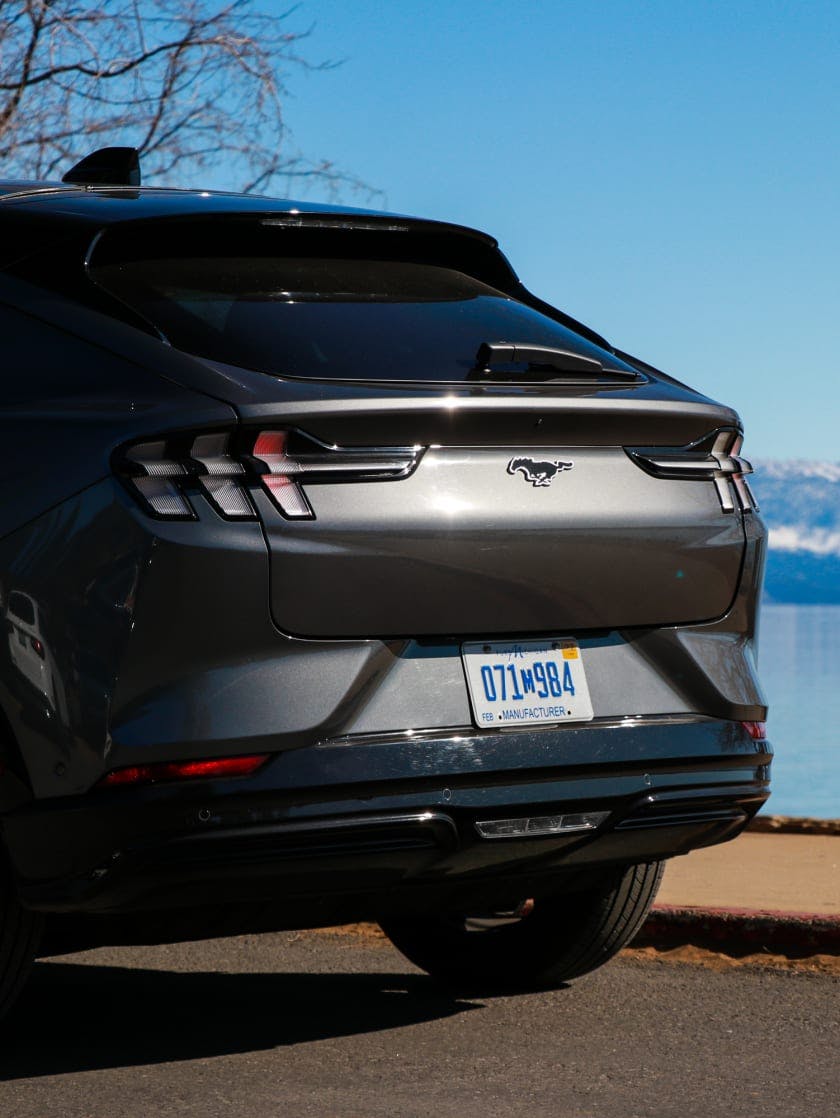

The Mach E has been one of the more controversial designs over the last year and it was clearly going to be a challenge for the Ford designers to develop a crossover-SUV concept and integrate the iconic styling cues of the original Mustang. I think they have really delivered on this and I really like the aggressive front end, the high headlights, the ridges on the hood and the contoured styling around the front fender that accentuates a powerful look.
Designing a comfortable four seat cross-over with a decent amount rear headroom is not easy, as Tesla has clearly proven with the Y, that in my humble opinion looks almost cartoonish with its high roof and short body. Ford, however, has done a really nice job with the Mustang, particularly with the way they have tapered the rear window and C pillar, with a recessed black roofline to disguise the height. They also cleverly hidden the door handles to add to the clean lines that make the Mach E look almost like a couple. The back of the Mach E features the iconic Mustang lights and the tailgate and rear wings are nicely contoured with wider hips that taper in to the rear fender. My only gripe about the design is that from some angles the track of the Mach E looks a bit narrow even with the 19 inch rims on the Premium version.
Stepping into the Mach E, the interior is spacious and functional and there is plenty of storage as the Mach E battery is located underneath the floor. The large 15.5 inch touch screen dominates the center of the dash housing the navigation, climate controls, media, and entertainment. They have added a physical dial to the screen, which is a nice touch and so much easier to use than sliders. I also really like that Ford has added a smaller a streamlined instrument cluster that shows range, ‘groundspeed’ and the really intuitive adaptive cruise control that is incredibly easy to use. All of the switchgear, other than the stop start, is located on the steering wheel, column stalks or the touch screen which gives the Mach E a very clean and minimalist feel.
The interior has a combination of fabric which integrates the Bang & Olufsen speakers, an imitation carbon fiber and stitched vinyl, that looks great and feels really-well put together. There is storage under the floating armrest, large door pockets and trays that incorporate a wireless phone charger. The seats are comfortable, though headroom in the back is a bit limited for tall adults, and there is plenty of light with the fixed panoramic sunroof. With a trip from SF to Tahoe I spent a good 10 hours or so driving and touring over 2-3 days and the seats remained comfortable.
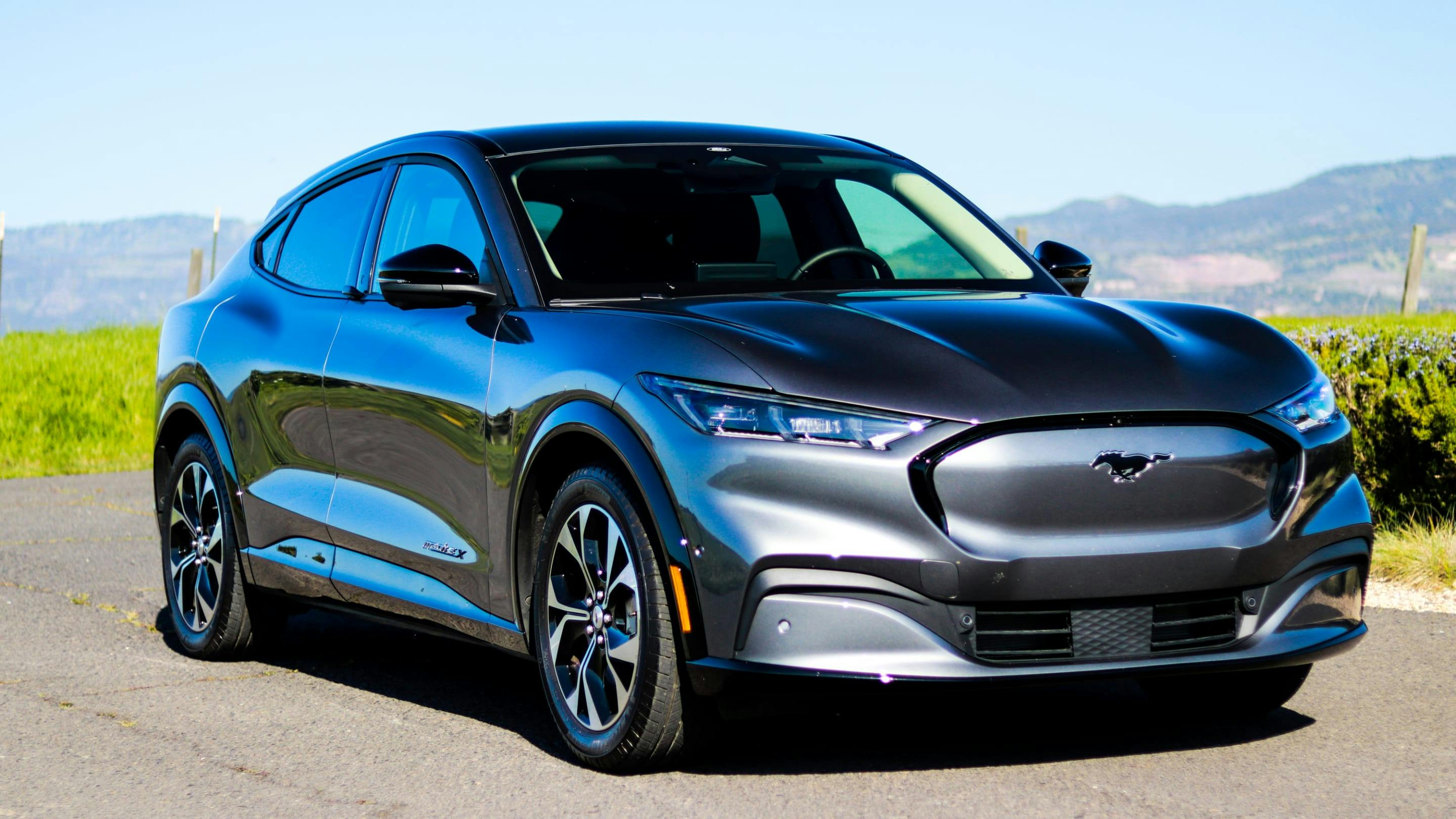
Overall the Mach E feels really well put together and very functional. Both the rear trunk and front trunk are functional, with the ‘frunk’ made of durable plastic that can drain and double as an ice box. The rear trunk is very accessible with the hatch and has 29 cubic feet of cargo space, which doubles to 60 with the rear seats folded.
The SYNC infotainment system cleverly uses machine learning to tailor the drivers experience and integrates Apple CarPlay, Android Auto, and has a mobile WiFi hotspot. The Bang & Olufsen audio system was excellent, though the navigation system took a bit of getting used to.
The Mach E is available with either a Standard Range 68 kWh battery or the extended range 88 kWh battery, which power an electric motor that is mounted on the rear of both axles.
My demo car was the Premium RWD with the extended range 88kWh, that gives it up to 305 miles of driving range. The 0-60mph performance with the larger battery and RWD is 6.8 seconds, which is slightly slower that the standard range car and 1.3 seconds slower than the AWD version. The torque on the RWD is 317 lb-ft compared to the AWD which is 428 lb-ft, however with the AWD the estimated range drops down to 270 miles. Personally, I would probably go for the Premium AWD with extended range for the additional torque and keeping in mind that most of the time you would charge the car at home and probably not do more than 100 miles or so a day.
On the road the Mach E handles well, the center of gravity is low and even in the RWD format it is responsive and feels pretty nimble. The steering is reasonably good and there are three driving modes, Whisper (“Seamless drive, calm and quiet”), Engaged (“Balanced drive, fun and engaging”) and Unbridled (Exhilarating drive, machine and road align as one”). The steering weights up and becomes and bit more precise and throttle response improves slightly in each mode, though other than that I could not detect a huge difference between the three. In Unbridled the Mach E can also emit a sonic exhaust tone to emulate an internal combustion V8, but it seemed more like white noise. I found that I kept the Mach E in “Engaged” mode all the time and it performed well and according to Ford the battery consumption is the same across all three modes.
The Mach E also has the brake regeneration system, which according to Ford activates whether driving in both normal driving and one-pedal mode. The one pedal mode initially took a bit of getting used to and I am not sure if it was just taking time to calibrate the right foot or if the car was a bit clunky coming on and off the throttle at low speeds. My initial results with the Mach E produced some slightly awkward starts and stops at the lights with a few glares. But once I assimilated, the one pedal driving was excellent and really easy not to use the brakes.
I also particularly liked the adaptive cruise control, which was superb and I found that I used it constantly for highway driving. The thumb switches on the wheel were easy to use and very intuitive, particularly in resetting the distance between cars ahead. Coupled with the one-pedal mode, I found the Mach E surprisingly relaxing and easy to drive in traffic, this would be a fantastic commuter car.
During my week with the Mach E, I ventured up to our Exclusive Resorts homes in Tahoe thinking this would be a good opportunity to see how practical the charging network is. This is a 200-mile trip each way and without a charger at either my house or at our homes in Tahoe, it would be an adventure to see how easy it was with the electric Mustang. The Mach E comes with a Ford Mobile Charger that can be used with a 120-volt outlet, but this literally charges at 3 miles per hour, so the only practical option would be to use the DC Fast Charging stations en-route.
The charging network in Northern California is already pretty well established and developing quickly, particularly with EVgo and Chargepoint and Electrifyamerica. Most of the charge stations are conveniently located and easy to find on the FordPass App, so alleviate the so-called ‘range-anxiety’. The night before I went to the EVgo at my local Whole Foods in Mill Valley, and after a few challenges with the connection I had to call EVgo, who gave me a complimentary charge. Overall however, charging is straightforward, you can use either the Ford Pass App or download Apps from EVgo, Chargepoint or Electrifyamerica and they will direct you to the closest charging stations, they will also let you know which chargers are available or in use. In most cases these charge points are conveniently located shopping centers or hotel car parks a 20-40 minute charge at the DC fast charger gets you back up to around 60-80% of battery life. Though charging slows as it reaches 80% and a full charge will take a couple of hours. So an extended road-trip just takes a little bit of extra planning and you need to be patient enough to spend 20-30 mins to top up the battery and coordinate your trip and breaks around it.
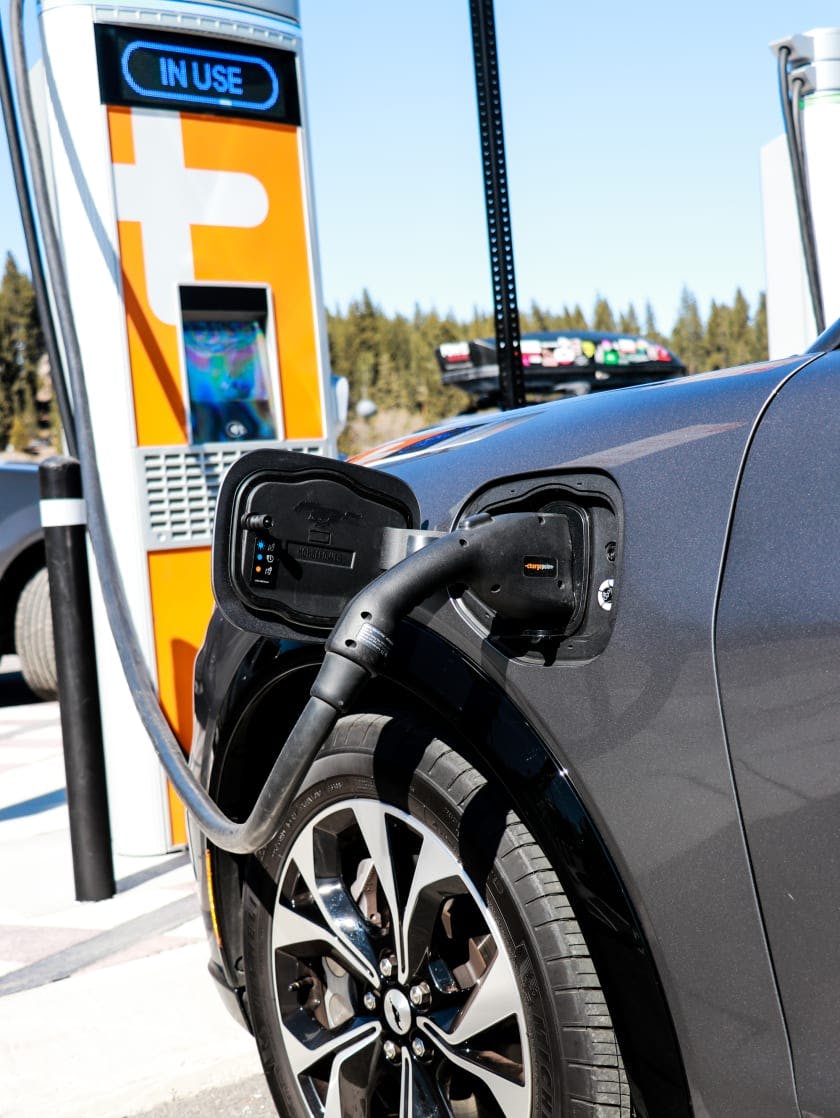

The charging network, and etiquette, still needs some evolution and whilst the FordPass app offers access to a large network of charging stations, they are managed by different providers and the experience can be very inconsistent. These are all unattended sites and you will find that people inadvertently park their non-electric vehicles in the dedicated spots and in some places there is a tendency to leave vehicles in the spots even when they are fully charged, which can be super frustrating when there are only a couple of charge points. The charge companies levy an extra fee for those that overstay their welcome, but it is still a bit irritating. Also, the plastic connectors on the chargers can get battered and take a bit finagling to get in and out of the port on the car. This is an area where Tesla seems to have a clear advantage, as the charging system, chargers and connectors are all part of the Tesla system—they are well designed, consistent and seem to be better maintained. The charge port on the Tesla’s are also nicely hidden behind the rear light reflector, and I am not sure if this was by design, but as the charge point is at the rear of the vehicle, the cars are always facing neatly out in a row, which for someone like me that’s a bit OCD is a nice touch.
With a well-established and rapidly growing charging network, these issues will surely improve and the range-anxiety issue will become less of a factor, it is just more of an inconvenience to be factored into planning on longer trips. For the most part the Mach E will anyway primarily be used for local trips and charged overnight on a 240v Ford home charger, which charges at around 28 miles per hour and will give a full charge from 0-100% in 10.9 hours.
With the Mach E Ford is clearly primarily going head-to-head with the Tesla model Y, which is Tesla’s compact crossover SUV. Other options would be the Polestar-2 and Jaguar I-Pace. It has been a long time since I have driven a Tesla, which was an early iteration of the S Model and so I can’t make an effective comparison on handling. However, the stats between the Mach E and Tesla Y are close particularly on range, performance and pricing. I think the Tesla would clearly win on the charging network, but in my view the Mach E wins on aesthetics and design. I just can’t quite come to terms with the Tesla design, they seem a bit vanilla and unimaginative. Where Tesla has been so brilliant, however, is that they have made the process of purchasing and ownership frictionless and seamless, entirely circumventing the daunting dealership experience.
My demo car was specification was a Premium RWD with the extended range 88 kWh battery, in grey metallic. The base price of the Premium RWD is $47,600 and the extended range batter adds another $5,000, bringing it to $52,600, which is not inexpensive for a car of this size. This however, doesn’t include the $7,500 Federal Tax Credit offset. The base price of the GT is $59,900 and can get up to $64,900 for the performance edition with the extended battery.
Overall, I really enjoyed my time with the Mach E, it is a really good car – practical, comfortable, and a very versatile runabout. It acquitted itself extremely well on my trip up to the mountains. Performance was lively though nothing exceptional, but I don’t think that really matters too much with a car like this. The performance numbers of these electric cars look great on paper, but I don’t think they factor that much into daily live-ability. Which is probably why I would personally buy the AWD extended range Premium version over the GT.
Ford has pledged to go all electric by 2035 and it seems they have certainly ‘Woke Up’ to the electric revolution and inevitability of the electric automobile. After my week with the Mustang I would definitely buy one, and it would certainly be my preference over a Tesla, as I much prefer the design of the Mach E. Though for now it might be a second car until the away-from-home charging network becomes a bit more user-friendly.
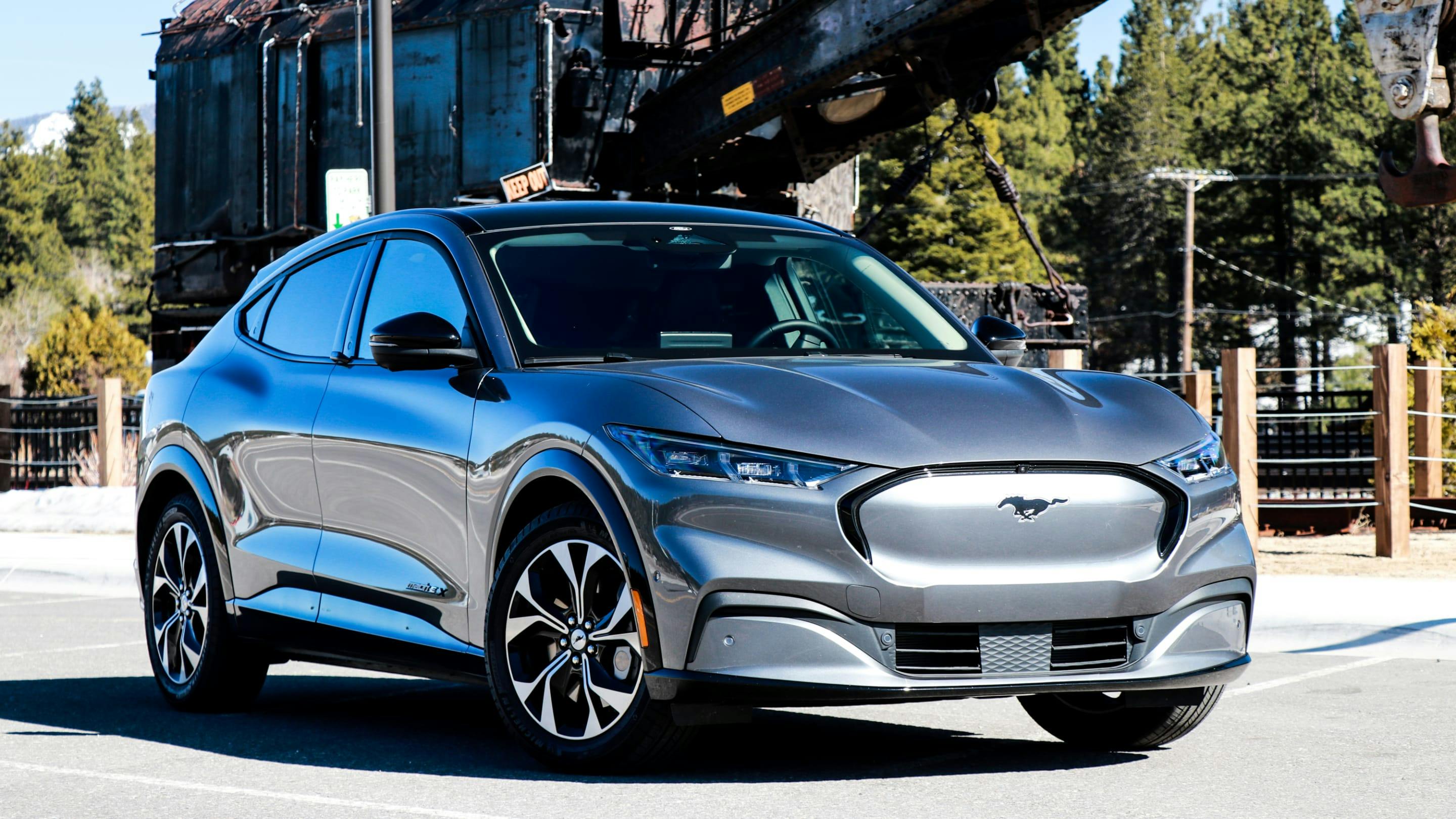
I have certainly softened a bit and and after my week with it, the electric Mustang has definitely warmed my heart. It is incredibly user friendly and I can absolutely see the appeal. Perhaps I can be a convert to the electric revolution after all.
Though, I can’t say the same about kombucha, and I certainly ain’t eating no kale...
.















